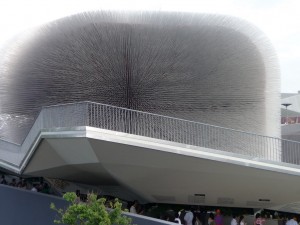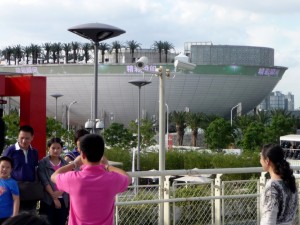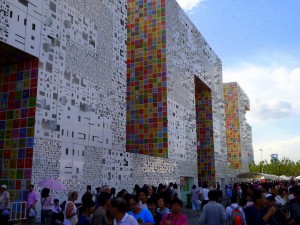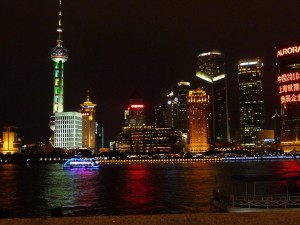More than 190 countries are displaying their culture and architecture at the Expo 2010 in Shanghai, China. The Expo will run until October 31, 2010. My brother-in-law, Dan Jay (who is an architect in St. Louis at Christner, Inc.) kindly allowed me to publish some of his many photos of the pavilions of participating nations; he returned from the Expo only a few days ago. Click on the photos for expanded views. What you will see immediately below is the U.K. Pavilion, The 20-meter-high cube-like Seed Cathedral is covered by 60,000 slim, transparent acrylic 7-meter long rods, which quiver in the breeze, each of these rods containing a certain type of seed. This exhibit is designed to be a call from the UK to protect our natural species.
 The Pavilion from Saudi Arabia includes 150 date palms on the roof:
The Pavilion from Saudi Arabia includes 150 date palms on the roof:
 Here is the dramatically inverted Chinese pavilion:
Here is the dramatically inverted Chinese pavilion:
 Next up is the Korean pavilion:
Next up is the Korean pavilion:
 Many of the structures featured biomass (I cannot remember which country built the following).
Many of the structures featured biomass (I cannot remember which country built the following).
You can view images of many of the other stunning structures here (and also see the gallery here). You’ll see that architectural creativity abounds in Shanghai, and that it includes gravity defying outcroppings and organic shapes. You might expect such a spectacular show, given that it occurred in such a vibrant city.




Dan Jay emailed me with the following supplemental information regarding his recent trip to China. Tongue in cheek, he asked that I give him the title of "China Correspondent."
Therefore, what follows is a report from DI's China Correspondent, Dan Jay:
I have recently returned from a seven day tour of China, a tour organized and sponsored by the Chinese government. In the months before the trip I read about China’s astonishing ancient and recent history. Surely such extensive research and the personal experience of the trip make me an unqualified expert. Or surely not. Regardless, I should, and will, share a few observations.
Understanding the history helps. For two thousand years the Chinese were sure that they were the center of the universe. During the colonial and early revolutionary times there was some doubt, but they have boldly reclaimed international prominence with explosive economic growth, manifested in the Olympics and the 2010 Shanghai Expo. Twenty two hundred years ago the empire established a tradition of strong bureaucratic control governed by a central single power. The communist party version of this, despite the revolutionary rhetoric, is not all that different from the dynasties of the past.
Our concept of capitalist free enterprise competition is dependent on a “free” society and a government providing the least necessary regulation and interference. This formula, we have long believed, assures our long established economic dominance. China now presents a totally different model: government as the business enterprise. Since the opening up of the economy after the death of Mao, the centralized economy has added the secret sauce of private enterprise and an aggressive push to capture foreign export markets and resources to import. Our antiquated notion of enterprise is up against a new competitor with absolute power, almost unlimited capital, business savvy, and the ability to take extraordinary risks. Good luck with that.
Two issues threaten the behemoth. The first is the unpredictability of authoritarian regime change. The last thirty years have been blessed by progressive and responsible leadership. This could change through any number of forces leading to mis-management of the massive economy, or the militarization of the Chinese society.
The second issue is the inevitable implications of the one child policy, now in its 30th year. The couples first affected by this are in their mid fifties, close to early mandatory retirement. Each single child will be contributing to the economy the means to support their parents, surviving grand parents, and their own one child nuclear family. Roughly speaking this is one worker supporting, on average, about four non-workers. This change is right around the corner, but its impact might take years to develop.
Dan, the September 17, 2010 edition of Science (available online only to subscribers), contains an article by Mara Hvistendahl titled "Has China Outgrown the One Child Policy?" This is an excellent article, detailing the reason for the policy in 1980 (in the eyes of of Chinese party officials), as well as the precarious situation China is now in, thanks to this policy. Here are a few excerpts: